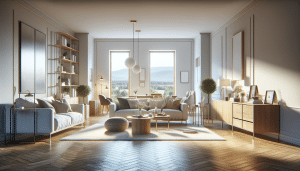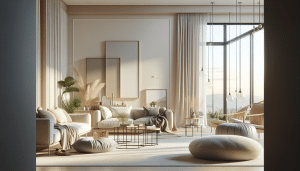Secrets of Minimalist Living Most Ignore
Jessica White September 14, 2025
Discover the mindful approach of minimalist living—where less truly means more satisfaction. Uncover how simplicity, functional design, decluttering, and intentional purchasing can transform your lifestyle and create more space for joy, balance, and personal growth.
The Essence of Minimalist Living
Minimalist living stands out in the world of lifestyle choices. The movement attracts those seeking simplicity, mental clarity, and a more intentional existence. At its core, minimalism revolves around reducing excess and focusing energy on fewer, well-chosen possessions and experiences. People gravitate to it for different reasons—some for sustainability, others for financial freedom, and many for peace of mind. The growing popularity of minimalist home design and mindful consumption reflects a global trend toward valuing quality over quantity, influencing everything from fashion and interior design to travel and relationships.
Creating harmony within your surroundings is an essential aspect of practicing minimalism. This approach is about stripping away the clutter, not just physically, but also mentally and emotionally. Many individuals notice improvements in stress levels and overall mood when transitioning to a minimalist environment. Spaces designed with functionality in mind often promote relaxation, allowing important activities and personal connections to take center stage. People frequently express that, after simplifying their lives, they have more time and attention to devote to passions, relationships, and well-being.
Minimalist living is often misunderstood as deprivation, but it’s about intentional abundance. Possessions are chosen deliberately for function, beauty, or sentimental value. This way of life advocates for mindful spending and encourages individuals to think critically before purchasing new items. Adopting a minimalist perspective makes room for meaningful experiences—like spending time outdoors, developing hobbies, or simply enjoying a clutter-free living room. The result is a sense of freedom and contentment that sparks joy on a daily basis.
Benefits of Decluttering for Your Mind and Space
Decluttering is an actionable step that often accompanies minimalist living. The practice goes beyond tidying up; it directly impacts mental clarity and reduced anxiety. Research indicates that cluttered spaces can increase cortisol levels, leading to persistent stress. A decluttered home doesn’t just look better—it feels better too, often promoting relaxation and creative thinking. Minimalist organization is not only about empty spaces but also about intentional arrangements and storage solutions that make daily routines smoother and more enjoyable (Source: https://www.apa.org/news/press/releases/2016/03/clutter-stress).
Minimalist homes frequently incorporate multi-purpose furniture. This approach maximizes usable space without sacrificing style or function. Those transitioning to a more minimalist environment often start by donating or recycling items that don’t serve a clear purpose or spark happiness. Over time, the absence of clutter makes cleaning and maintenance easier, providing extra hours for pursuits that contribute to well-being. Studies suggest that children in organized, minimalist environments demonstrate better focus, while adults report a sense of calmness and reduced decision fatigue.
For many, decluttering brings a newfound sense of control. The journey itself can be emotional, but it also provides insight into purchasing habits, sentimental attachments, and personal values. Minimalist living inspires practical routines for maintaining order, such as the “one in, one out” rule. With clutter out of sight, the mind becomes more open to creativity and rest. Many experts advise approaching decluttering gradually, focusing on one area at a time to prevent overwhelm and enhance lasting results (Source: https://www.cdc.gov/mentalhealth/stress-coping/managing-stress.htm).
Intentional Purchasing: How Minimalism Curbs Impulse Spending
Intentional purchasing is a hallmark of the minimalist lifestyle. It involves pausing before every purchase to consider necessity, quality, and longevity. In an age saturated with fast fashion and persuasive advertising, many people find themselves accumulating unnecessary items. Adopting a minimalist approach helps break this cycle by espousing a mindful mindset. Before buying, questions like “Do I truly need this?” and “Will this bring lasting value?” foster more thoughtful decisions. This routine not only saves money but also reduces waste, aligning with sustainable living principles (Source: https://www.epa.gov/recycle/reducing-waste-what-you-can-do).
The financial impact of adopting intentional purchasing habits can be significant. Regular review of household expenditures often uncovers surprising patterns—subscriptions never used, duplicate clothing, or novelty gadgets gathering dust. Redirecting disposable income away from impulse purchases and toward savings or meaningful experiences is a driving force for many minimalist advocates. These choices often lead to greater long-term happiness and financial security, as studies have shown a positive relationship between simple living and reduced financial stress.
Reducing consumption creates positive ripple effects in the wider community. Supporting local artisans who focus on high-quality, long-lasting goods becomes more appealing. Gifting experiences rather than objects fosters deeper personal connections. Minimalist consumers also influence their social circles by modeling conscious habits. This movement, once associated with extreme minimalists, now appeals to mainstream audiences seeking a balanced, less material-centric lifestyle. Over time, minimalism leads to a shift in priorities from accumulation to fulfillment and purpose.
Minimalist Design in Interior Spaces
The aesthetics of minimalist design are characterized by clean lines, functional spaces, and a calming color palette. This style draws inspiration from Scandinavian and Japanese philosophies that emphasize harmony and utility. Rooms are arranged to maximize natural light and create open, airy environments. Furniture is selected for both its functionality and beauty—each piece should either serve a purpose or delight the senses. Simple wall art, lack of excessive décor, and hidden storage help keep the environment serene. These design principles often extend to digital spaces, with smartphone screens and desktop layouts organized for focus and productivity.
Adopting minimalist design principles in the home doesn’t require drastic renovations. Even small adjustments—such as clearing countertops or switching to modular storage—can make a noticeable difference. Many people find that an uncluttered aesthetic aids concentration and reduces the sense of chaos. Minimalist design trends now influence everything from tiny homes to urban apartments, making it adaptable regardless of space or budget. This approach is not just visually appealing but also environmentally conscious. Often, less furniture and fewer decorative items equate to less resource consumption and a smaller environmental footprint (Source: https://www.archdaily.com/934509/the-power-of-minimalism-in-interior-design).
The minimalist trend is increasingly present in sustainable home building. Natural materials, energy-efficient appliances, and eco-friendly finishes align with minimalist values. The absence of visual clutter can make features like picture windows, plants, and artwork stand out more vividly. Experts recommend starting with one room to create a minimalist sanctuary, then gradually expanding the design to other spaces. Minimalist interiors may seem sparse at first glance, but each element is carefully chosen, emphasizing the philosophy that in design, as in life, less can truly be more.
Building Mindful Routines to Support Minimalism
Mindful routines are a powerful support system for living minimally. By consistently evaluating needs and habits, it becomes easier to maintain a decluttered, intentional existence. Morning rituals might include reviewing the day’s priorities or spending time in a thoughtfully arranged space. This practice sets a calm, purposeful tone and reduces the likelihood of reverting to clutter and impulse buying. Incorporating mindfulness techniques like meditation, journaling, or focused breathing can deepen appreciation for simplicity. Many people find that these routines reinforce their commitment to living with less, helping to distinguish between want and need.
Evening routines centered on resetting spaces—putting items back in place, reviewing what was truly used, and letting go of excess—help keep minimalism sustainable. Weekly assessments, such as a “digital declutter” or closet review, prevent areas from becoming overwhelmed again. Living intentionally means reserving time for gratitude and reflection on how distilled surroundings impact well-being. Studies suggest regular mindfulness can improve cognitive function and emotional regulation, which complements lifestyle changes associated with minimalism (Source: https://www.ncbi.nlm.nih.gov/pmc/articles/PMC3004979/).
Social support can further bolster minimalist habits. Engaging with minimalist communities—whether online or locally—offers accountability, inspiration, and practical tips. Friends and family may also join the journey, creating collective motivation. Over time, these routines solidify, and what began as a deliberate strategy becomes second nature. Minimalist living is less about strict rules and more about a philosophy that grows with individual preferences and life changes. The key is returning often to the question: “Does this add value or joy to my life?”
Sustainable Minimalism and Global Impact
Sustainable minimalism recognizes the environmental benefits of mindful consumption. By purchasing fewer but higher-quality goods, individuals reduce demand for disposable items. This approach supports ethical businesses, decreases landfill waste, and lessens overall carbon footprints. Practices such as borrowing, repairing, or upcycling extend product lifecycles. The United Nations has highlighted the importance of reducing overconsumption to combat climate change and environmental degradation (Source: https://www.unep.org/news-and-stories/story/minimalism-sustainability-lifestyle-or-essential-climate-action).
Minimalist living also raises awareness about the global supply chain and labor practices. Opting for ethically sourced goods, avoiding single-use plastics, and embracing cyclical economies can drive industry change. Larger societal shifts occur when minimalist values are adopted on a broad scale. For example, growing interest in capsule wardrobes, small-space living, and zero-waste initiatives reflects a collective desire to balance comfort with responsibility. Even small actions, like swapping out disposable products for reusable alternatives, contribute significantly to sustainability goals.
Many people discover that sustainable minimalism strengthens their sense of connection to the wider world. Instead of accumulating things, the focus shifts to nurturing relationships and experiences. Volunteering, community engagement, and time outdoors replace shopping as sources of fulfillment. As more individuals and families adopt minimalist principles, a cultural shift toward responsible living gains momentum. Ultimately, minimalist living is a conscious effort—rooted in simplicity, mindfulness, and sustainable choice—that shapes not only personal well-being but the future of the planet.
References
1. American Psychological Association. (2016). Clutter causes stress. Retrieved from https://www.apa.org/news/press/releases/2016/03/clutter-stress
2. Centers for Disease Control and Prevention. (2022). Managing stress. Retrieved from https://www.cdc.gov/mentalhealth/stress-coping/managing-stress.htm
3. United States Environmental Protection Agency. (2023). Reducing waste: What you can do. Retrieved from https://www.epa.gov/recycle/reducing-waste-what-you-can-do
4. ArchDaily. (2020). The power of minimalism in interior design. Retrieved from https://www.archdaily.com/934509/the-power-of-minimalism-in-interior-design
5. National Institutes of Health, National Center for Biotechnology Information. (2011). Mindfulness practice leads to increases in regional brain gray matter density. Retrieved from https://www.ncbi.nlm.nih.gov/pmc/articles/PMC3004979/
6. United Nations Environment Programme. (2021). Minimalism and sustainability: Lifestyle or essential climate action? Retrieved from https://www.unep.org/news-and-stories/story/minimalism-sustainability-lifestyle-or-essential-climate-action








